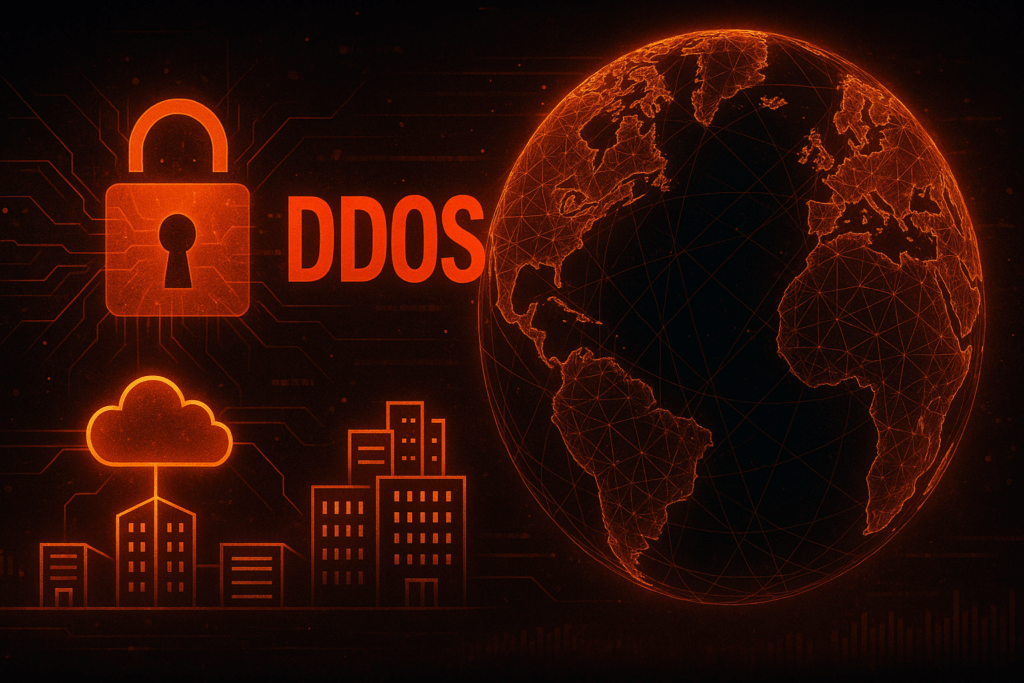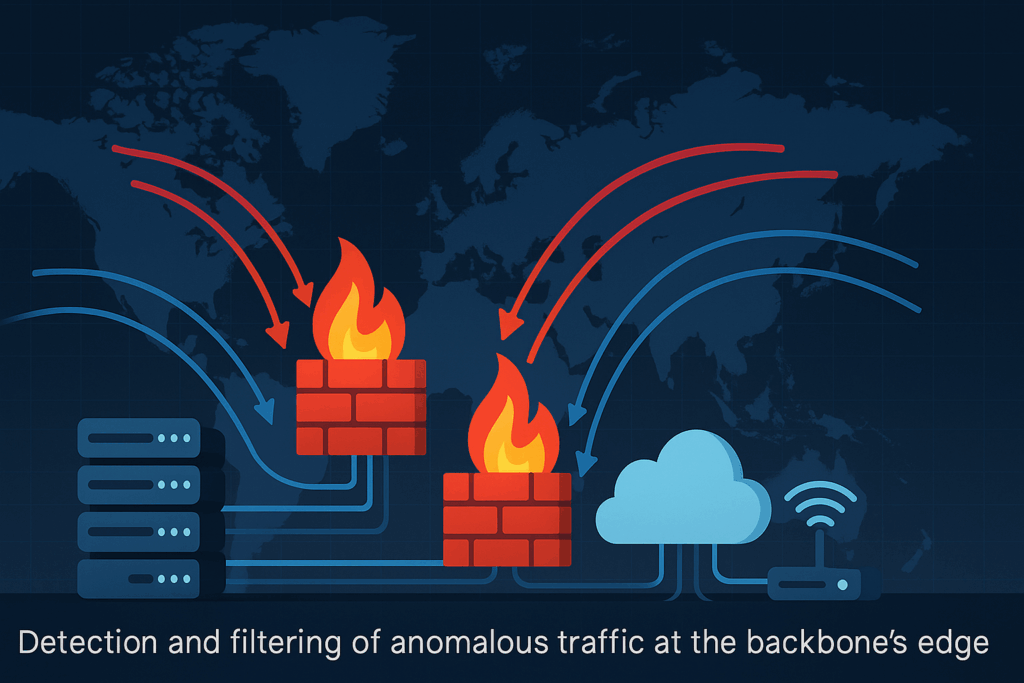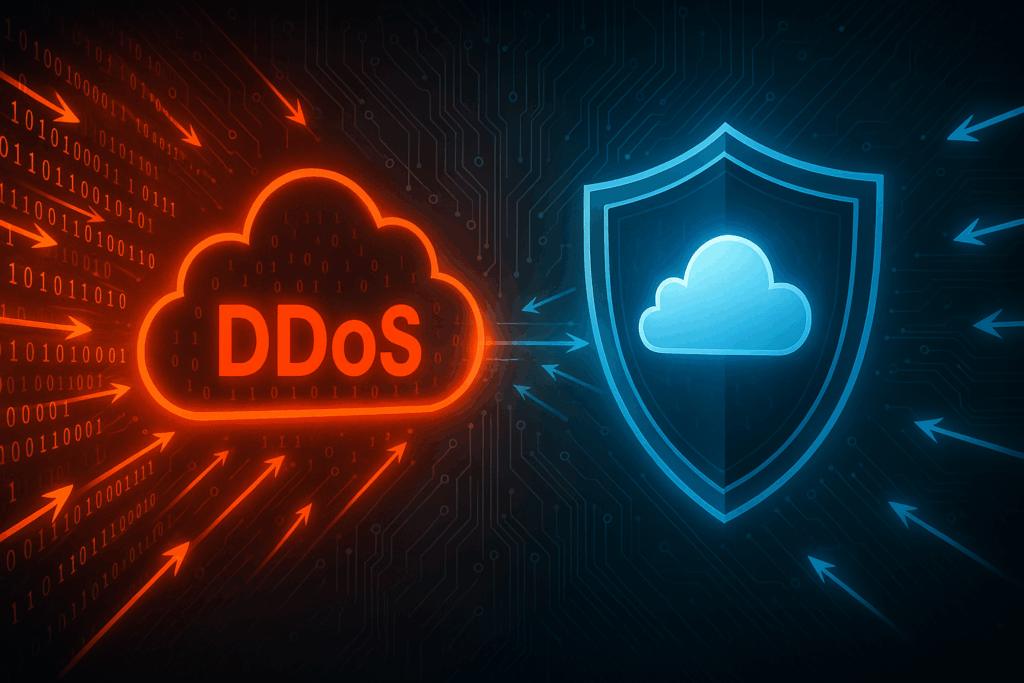On May 15, 2025, a new record was set in the history of cyberattacks: a distributed denial-of-service (DDoS) attack peaked at 7.3 terabits per second, becoming the largest ever recorded. The scale of this event surpasses all conservative predictions about the evolution of cybercrime and redefines the technical, strategic, and operational requirements that corporate cybersecurity defense teams must adopt.
This article analyzes the attack from a technical standpoint, with direct implications for hybrid architectures and mission-critical environments, including concrete prevention and response measures.

Hyper-volumetric Attacks: Anatomy of an Emerging Threat
The attack was intercepted by Cloudflare and targeted a hosting provider using their Magic Transit service, a network-layer DDoS mitigation solution. In just 45 seconds, the victim was hit with 4.8 billion packets per second (Mpps) and a cumulative volume of 37.4 terabytes. The malicious traffic originated from more than 122,000 IP addresses across 161 countries, indicating a globalized botnet spread across thousands of compromised autonomous systems.
Technically, the attack was multivectorial, reinforcing a trend observed in previous quarters: modern DDoS campaigns are no longer focused solely on bandwidth saturation. Instead, they aim to exhaust CPU resources, state tables, and deep packet inspection engines. 99.996% of the traffic consisted of UDP floods, using protocols like QOTD, Echo, NTP, RIPv1, and variants of the Mirai malware, each chosen for its amplification potential and poor signal-to-noise ratio for traditional detection tools.
Automated Defense: An Indispensable Requirement
One of the most remarkable aspects of the mitigation process was its fully automated nature. Cloudflare’s infrastructure, based on anycast routing and a globally distributed presence, absorbed the attack without any human intervention. This highlights a critical point: human teams can no longer respond manually to incidents of this magnitude in real time. Any organization still relying on semi-manual processes to contain network threats is at a clear strategic disadvantage.
Detection and filtering of anomalous traffic occurred at the backbone’s edge, preventing the attack from even reaching the client’s network. This ability to contain threats at the periphery should inspire corporate teams to replicate similar architectures using hardened CDNs, scrubbing centers, smart transit services, or SD-WAN-integrated solutions that enable dynamic traffic rerouting.

Direct Implications for Corporate Environments
This attack does not only affect global tech platforms. The capability to launch hyper-volumetric offensives from home routers or poorly secured embedded systems means that medium-sized businesses and critical local infrastructures are also in the crosshairs. Any organization exposing internet-facing services such as VPNs, APIs, remote desktops, or admin portals is a potential target for saturation in seconds.
Organizations relying on real-time critical interconnections, such as those in the industrial, healthcare, or financial sectors, must recognize that even a brief traffic spike can disrupt not only external availability but also internal latency and system stability. The same applies to business continuity environments: recovery plans and high availability architectures often assume DDoS attacks will be slow or progressive.
The May incident proves this assumption wrong. The techniques, speed, and duration of the attack show that DDoS has evolved into an effective tactic for distraction or as a prelude to more destructive phases—such as ransomware or wiper deployment. Ignoring this shift is equivalent to leaving an open gap in the broadest perimeter: reaction time.
Advanced Mitigation Strategies: Beyond the Firewall
Defense teams must abandon the idea that conventional firewalls or signature-based IDS systems can offer sufficient protection against threats of this scale. The strategy must be multi-layered, with each layer capable of autonomous action and distributed visibility.
A first defensive tier should rely on specialized cloud-based DDoS mitigation services like Azure DDoS Protection, AWS Shield Advanced, or Akamai Kona. These services can filter and reroute malicious traffic in the cloud before it ever reaches on-prem infrastructure, freeing local devices from the burden of processing billions of packets per second.

At the internal network level, real-time flow-based monitoring, via NetFlow, IPFIX, or sFlow, is essential. Security teams must be able to quickly assess whether a link is saturated, whether there’s asymmetry between nodes, or if latency has abruptly spiked. Integration with a SIEM or XDR platform is no longer optional; it’s critical to correlate network anomalies with other indicators such as failed logins, access to sensitive endpoints, or lateral movement attempts.
Continuous analysis of internal traffic behavior is equally important to detect signs of congestion, excessive buffering in switches, or unexpected packet loss. This not only helps anticipate attacks but also supports incident response during legitimate operational overloads.
Protocol hygiene must also be addressed. Legacy or unnecessary protocols like QOTD, Echo, or Chargen, still enabled on poorly configured devices, should be blocked at the network edge. Their mere presence can enable massive amplification attacks with minimal effort from the adversary.
From an architectural perspective, logical segmentation of security domains is essential. Traffic between critical zones and exposed interfaces must be mediated by deep packet inspection engines or advanced proxies. Resilience must be designed into the network: every path to essential services should have redundant routes, active-active load balancing, and predefined failover thresholds.
Infrastructure should also be subjected to regular stress testing and Red Team simulations to evaluate how the system responds under real attack conditions, how quickly it detects anomalies, and what operational impact occurs. These exercises must be part of the security lifecycle, not isolated or symbolic gestures.
From an organizational standpoint, every defense team should maintain a DDoS-specific playbook, clearly differentiated from other network incident response plans. It should include activation criteria, escalation paths, internal communication protocols, external vendor coordination, assigned roles, and structured documentation for post-incident analysis. NIST SP 800-61r2 explicitly recommends treating DDoS events as a distinct category due to their unique technical and operational characteristics.

The Role of Threat Intelligence in the New DDoS Era
Cloudflare’s analysis makes it clear: the global volume of DDoS attacks is not just growing, it’s accelerating. In Q2 2025, more than 6,500 attacks exceeded 1 Tbps or 1 Bpps, a 44% increase compared to the same quarter the previous year. The threat is increasingly democratized. It no longer depends solely on nation-state actors or elite criminal organizations with privileged infrastructure.
This reality demands that threat intelligence become a core component of defense. Teams must consume, correlate, and act upon indicators related to active DDoS campaigns, growing botnets, command-and-control IPs, emerging TTPs, and anomalous behavior in specific regions. Sources such as MISP, VirusTotal Graph, Feedly CTI channels, and national CERT advisories must be tightly integrated into SOC workflows.
Membership in sector-specific communities like ISACs adds further value by enabling early threat sharing, identifying common targets, and improving collective defense posture. From a MITRE ATT&CK standpoint, teams must map and track techniques such as T1498 (Network Denial of Service) and T1499 (Endpoint Denial of Service), along with their environment-specific variants.
The Lesson: Automate, Distribute, Anticipate
The 7.3 Tbps attack is not an outlier, it’s a turning point. If such a volume can be generated from a distributed mesh of compromised devices, there’s no reason to assume that smaller-scale, more targeted variants won’t be used to disrupt a specific business, public service, or supply chain. Resilience must stop being a theoretical goal and become a fundamental property of digital architecture.
Defense can no longer depend on human reaction once an attack is underway. Decisions must be automated, distributed, contextual, and informed by dynamic intelligence. Modern cybersecurity defense is a living discipline, built on real-time data, immediate action, and continuous adaptation. Anything less is, at its core, unprotected.
